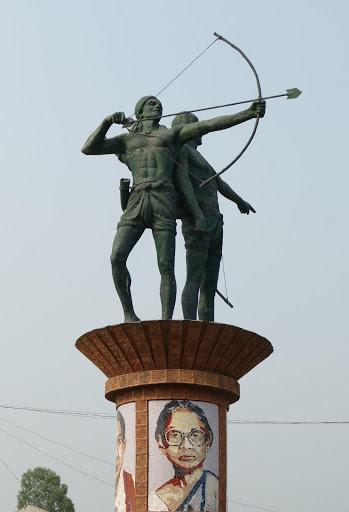
PUMPA - SMART LEARNING
எங்கள் ஆசிரியர்களுடன் 1-ஆன்-1 ஆலோசனை நேரத்தைப் பெறுங்கள். டாப்பர் ஆவதற்கு நாங்கள் பயிற்சி அளிப்போம்
Book Free DemoThe Santhal Rebellion (1855-56)
Reason: police brutality, exploitation of peasants by landlords and moneylenders and the British Government's ban on shifting cultivation in forest areas.
Area: Raj Mahal hills. Bihar.
Leaders: Siddhu and Kanhu (Santhal brothers)
The Santhals are the largest tribal community in India today, as per the population data. They are predominantly native to the states of Jharkhand, West Bengal and Odisha.

Statue of Sidhu and Kanhu in Dinajpur District
Course of the Revolt:
On 30th June 1855, the Santhal brothers (Sidhu Murmu and Kanhu Murmu) organised 10,000 Santhals and rebelled against the British. The tribals took an oath to drive away the British from their motherland. When the police arrived to arrest the Murmus, the villagers halted the policemen and killed them. They also attacked the British officials and engineers.
The landlords supported the British government, whereas the locals backed the Santhals. As a result, Santhals captured large chunks of land, including the Rajmahal Hills, Bhagalpur district and Birbhum.
Result
The government pacified these Santhals by creating a separate district of Santhal Parganas. The British passed the Santhal Parganas Tenancy Act in 1876, which offered some protection for the tribals against exploitation.
Champaran Satyagraha (1917-18)
Area: Champaran district of Bihar.
European planters forced Indian peasants to plant Indigo on 3/20th\ of their land holding under the Tinkathia system. Under this system, European planters holding the leases from the big local zamindars forced the peasants to cultivate Indigo which they purchased for significantly lesser prices.
In 1916, a farmer Raj Kumar Shukla from Champaran contacted Gandhi during the Lucknow session of Congress.
In 1917, Mahatma Gandhi launched an agitation against the acute attitude of European planters. He demanded a detailed enquiry and redressal of farmers’ grievances.

Stamp Release on Raj Kumar Shukla by Indian Postal Department in 2000.
Result:
- The government appointed a committee and included Gandhi as one of its members.
- The government abolished the Tinkathia system and paid compensation to the farmers.
- The peasants' grievances were enquired, and eventually, the Champaran Agrarian Act was passed in May 1918.
Reference:
Image source: https://en.wikipedia.org/wiki/File:Stamp_Release_on_Raj_Kumar_Shukla.png